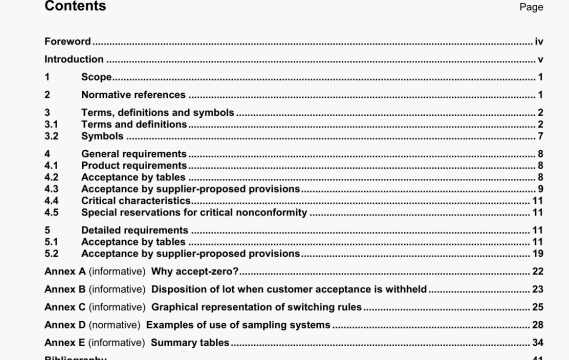ISO 21247 pdf download – Combined accept-zero sampling systemsand process control procedures for product acceptance.
4 General requirements
4.1 Product requirements
The supplier is required to submit product that meets all contract and specification requirements. The appbcation of the 5arnphng systems or procedures of this International Standard does not relieve the supplier of responsibility from meeting all contract product requiremeflts The supplier’s quality management system, including manufacturing processes and quality control measures, shall be established and operated to produce products that consistently meet all requlrernents Absence of any Inspection or process control requirements in the contract does not relieve the supplier of responsdlty for assuring that all products meet or exceed the customers requirements.
4.2 Acceptance by tables
4.2.1 Preferred sampling systems
This International Standard presents three types of matched sampling systems for the sampling inspection of product submitted to the customer for acceptance. These sampling systems provide for inspecting the samples from lots by measurement of attributes or variables and for continuous sampling by measurement of attributes. The three types of matched sampling systems are indexed by seven specified verification levels (VI) and five sample-size code letters (Ct.). Approximately the same level of protection is provided by each of the three types, when using the same code letter and verification level. The supplier has the option to utilize the type of sampling system, at the same verification level, that best complements the production process.
4.2.2 Formation and identification of lots
The product shall be assembled into identifiable lots or sub-lots or in such other manner as may be prescribed. Each lot shall, as tar as practicable, consist of Items of product of a single type, grade, class, sIze and composition, manufactured under essentially the same conditions and at essentially the same time. The lots shall be identified by the supplier and shall be kept intact in adequate and suitable storage space. Although lot size Is not used to select a continuous sampling plan, the formation of lots may remain desirable for reasons of homogeneity. shipping convenience and facilitation of payment,
4.2.3 DeterminatIon of sampling plan
A sampling plan in accordance with this International Standard is determined by all of the following:
a) verification level (VI);
b) type of quality characteristic (i.e. attribules or variables):
c) type of sampling (i.e. single sampling or continuous sampling):
d) sample-size code letter (CL);
e) inspection severity (normal, tightened, reduced).
4.2.4 Sampling of lots
4.2.4.1 Selection of items
Using simple random sampling, items of product shall be drawn from the lot without regard to their quality. Simple random sampling requires that each item In the lo or production Interval has the same probability of being selected for the sample. It is recommended that random number tables, computer programs or other suitable means be used for obtaining randomness in sampling rather than relying solely on human selection.
5.1.1.5 SamplIng procedures
Sampling is performed at one of three inspection seventies called normal, tightened and reduced. Unless otherwise specified, the Vi. stated In the contract shall be considered the noimal seventy of Inspection and shall be used at the start of inspection. The tightened and the reduced seveitties are then defined as the VL5 to the immediate left and right, respectively, of the initial seventy of Table 2. 3 or 4 The sampling inspection severity tn effect shall continue unchanged for each group of characteristics or Individual characteristic except where the switching procedures given in 5.1.1.6 requle change The switching procedures shal be applied separately to each individual characteristic except where characteristics are specified as belonging to a group with a single VL that applies to the entire group.
5.1.1.6 SwItching rules and procedures
5.1.1.6.1 General
The procedures for switching among normal, tightened, and reduced Inspection e given in Note 2 m
Tables 2. 3 and 4. Annex C provides additional guidance for following the switching procedures.
The switching procedures are independent of the results of any remedial action, such as screening, additional
samples. etc.. resulting from the occurrence of sample nonconformities and withholding of acceptance.
Some Table 4 switching criteria depend upon a corresponding Table 2 entry. These entries have b6fl denoted by ri5(N) and n(T) in the descriptions that follow. n5(N) represents the Table 2 sample size used for normal sampling at the VI and CL currently in effect. Likewise. njr) represents the sample size under tightened inspectio.i
5.1 .1 .6.2 Normal to tightened
When normal inspection is in effect, tightened inspection shall be mstituted when one of the following conditions occurs, depending on the type of sampling being used.
a) In the case of lot sampling (Tables 2 and 3):
two lots have been withheld from acceptance within the last 5 or fewer lots.
b) In the case of conti’iuous sampling (Table 4).
ISO 21247 pdf download – Combined accept-zero sampling systemsand process control procedures for product acceptance
